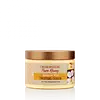What's inside
What's inside
 Key Ingredients
Key Ingredients

 Benefits
Benefits

 Concerns
Concerns

 Ingredients Side-by-side
Ingredients Side-by-side

Water
Skin ConditioningButyrospermum Parkii Butter
Skin ConditioningGlycerin
HumectantCetearyl Alcohol
EmollientGlyceryl Stearate
EmollientCocos Nucifera Oil
MaskingMangifera Indica Seed Butter
Skin ConditioningCetyl Alcohol
EmollientParfum
MaskingCetrimonium Chloride
AntimicrobialPanthenol
Skin ConditioningCarthamus Tinctorius Seed Oil
MaskingArgania Spinosa Kernel Oil
EmollientMel
EmollientCocos Nucifera Fruit Extract
EmollientLauryl Alcohol Diphosphonic Acid
Emulsion StabilisingPentylene Glycol
Skin ConditioningTetrasodium EDTA
Lauric Acid
CleansingTocopheryl Acetate
AntioxidantPhenoxyethanol
PreservativeBenzyl Alcohol
PerfumingCI 19140
Cosmetic ColorantCI 15985
Cosmetic ColorantWater, Butyrospermum Parkii Butter, Glycerin, Cetearyl Alcohol, Glyceryl Stearate, Cocos Nucifera Oil, Mangifera Indica Seed Butter, Cetyl Alcohol, Parfum, Cetrimonium Chloride, Panthenol, Carthamus Tinctorius Seed Oil, Argania Spinosa Kernel Oil, Mel, Cocos Nucifera Fruit Extract, Lauryl Alcohol Diphosphonic Acid, Pentylene Glycol, Tetrasodium EDTA, Lauric Acid, Tocopheryl Acetate, Phenoxyethanol, Benzyl Alcohol, CI 19140, CI 15985
Water
Skin ConditioningButyrospermum Parkii Butter
Skin ConditioningCocos Nucifera Oil
MaskingMacadamia Ternifolia Seed Oil
EmollientMangifera Indica Seed Butter
Skin ConditioningPersea Gratissima Oil
Skin ConditioningGlycerin
HumectantAloe Barbadensis Leaf Extract
EmollientHydrolyzed Silk
HumectantMyrtrimonium Bromide
PreservativeMelia Azadirachta Seed Oil
EmollientDaucus Carota Sativa Seed Oil
EmollientSorbitol
HumectantPanthenol
Skin ConditioningCaprylyl Glycol
EmollientOcimum Basilicum Oil
MaskingLonicera Caprifolium Flower Extract
PerfumingLonicera Japonica Flower Extract
Skin ConditioningTocopherol
AntioxidantHibiscus Syriacus Flower Extract
AntioxidantWater, Butyrospermum Parkii Butter, Cocos Nucifera Oil, Macadamia Ternifolia Seed Oil, Mangifera Indica Seed Butter, Persea Gratissima Oil, Glycerin, Aloe Barbadensis Leaf Extract, Hydrolyzed Silk, Myrtrimonium Bromide, Melia Azadirachta Seed Oil, Daucus Carota Sativa Seed Oil, Sorbitol, Panthenol, Caprylyl Glycol, Ocimum Basilicum Oil, Lonicera Caprifolium Flower Extract, Lonicera Japonica Flower Extract, Tocopherol, Hibiscus Syriacus Flower Extract
Ingredients Explained
These ingredients are found in both products.
Ingredients higher up in an ingredient list are typically present in a larger amount.
This ingredient is also known as shea butter. It is an effective skin hydrator and emollient.
Emollients help soothe and soften your skin. It does this by creating a protective film on your skin. This barrier helps trap moisture and keeps your skin hydrated. Emollients may be effective at treating dry or itchy skin.
Shea butter is rich in antioxidants. Antioxidants help fight free-radicals, or molecules that may harm the body. It is also full of fatty acids including stearic acid and linoleic acid. These acids help replenish the skin and keep skin moisturized.
While Shea Butter has an SPF rating of about 3-4, it is not a sunscreen replacement.
Shea butter may not be fungal acne safe. We recommend speaking with a professional if you have any concerns.
Learn more about Butyrospermum Parkii ButterCocos Nucifera Oil is obtained from the kernels of the coconut fruit. In other words, this is coconut oil.
Coconut Oil is rich in fatty acids with lauric acid making up the majority of these. It also contains linoleic acid. Due to this high fatty acid content, coconut oil helps trap moisture and soften skin.
Despite being antibacterial, coconut oil may not be great for acne-prone skin. It is comedogenic and may clog pores. This ingredient may not be safe for malassezia or fungal acne.
Note: Coconut Oil should not replace your sunscreen for UV protection. Studies show it only blocks about 20% of UV.
This oil is non-volatile and has a light scent.
The term 'fragrance' is not regulated in many countries. In many cases, it is up to the brand to define this term. For instance, many brands choose to label themselves as "fragrance-free" because they are not using synthetic fragrances. However, their products may still contain ingredients such as essential oils that are considered a fragrance.
Learn more about Cocos Nucifera OilGlycerin is already naturally found in your skin. It helps moisturize and protect your skin.
A study from 2016 found glycerin to be more effective as a humectant than AHAs and hyaluronic acid.
As a humectant, it helps the skin stay hydrated by pulling moisture to your skin. The low molecular weight of glycerin allows it to pull moisture into the deeper layers of your skin.
Hydrated skin improves your skin barrier; Your skin barrier helps protect against irritants and bacteria.
Glycerin has also been found to have antimicrobial and antiviral properties. Due to these properties, glycerin is often used in wound and burn treatments.
In cosmetics, glycerin is usually derived from plants such as soybean or palm. However, it can also be sourced from animals, such as tallow or animal fat.
This ingredient is organic, colorless, odorless, and non-toxic.
Glycerin is the name for this ingredient in American English. British English uses Glycerol/Glycerine.
Learn more about GlycerinMangifera Indica Seed Butter isn't fungal acne safe.
Panthenol is a common ingredient that helps hydrate and soothe the skin. It is found naturally in our skin and hair.
There are two forms of panthenol: D and L.
D-panthenol is also known as dexpanthenol. Most cosmetics use dexpanthenol or a mixture of D and L-panthenol.
Panthenol is famous due to its ability to go deeper into the skin's layers. Using this ingredient has numerous pros (and no cons):
Like hyaluronic acid, panthenol is a humectant. Humectants are able to bind and hold large amounts of water to keep skin hydrated.
This ingredient works well for wound healing. It works by increasing tissue in the wound and helps close open wounds.
Once oxidized, panthenol converts to pantothenic acid. Panthothenic acid is found in all living cells.
This ingredient is also referred to as pro-vitamin B5.
Learn more about PanthenolWater. It's the most common cosmetic ingredient of all. You'll usually see it at the top of ingredient lists, meaning that it makes up the largest part of the product.
So why is it so popular? Water most often acts as a solvent - this means that it helps dissolve other ingredients into the formulation.
You'll also recognize water as that liquid we all need to stay alive. If you see this, drink a glass of water. Stay hydrated!
Learn more about Water